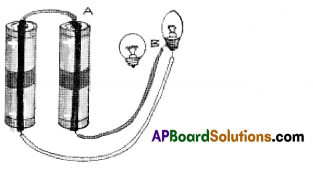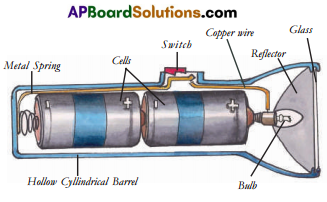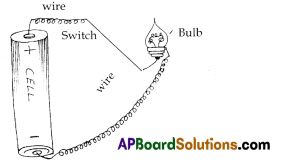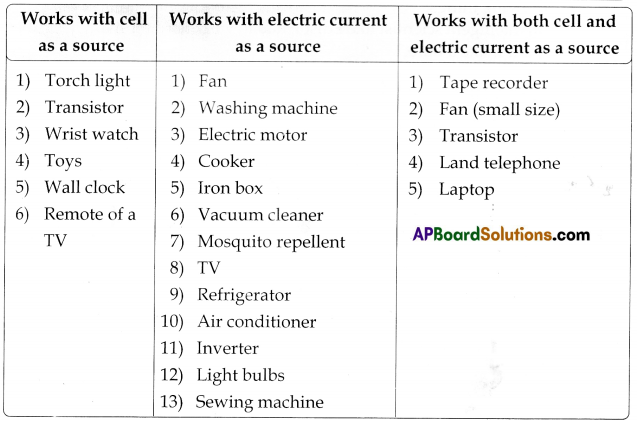TS Board 6th Class Science Guide Telangana 12th Lesson Simple Electric Circuits Textbook Questions and Answers.
TS 6th Class Science 12th Lesson Questions and Answers Telangana – Simple Electric Circuits
Question 1.
What is an electric circuit? Explain with a diagram.
Answer:

- Figure shows a closed circuit. It consists of a cell, a bulb and connecting wires.
- An electric circuit provides a complete path for electricity to flow between the cell and the bulb.
- A similar circuit exists for an electric bulb which we use in our houses.
- The two electric supply’ wires are connected to the two terminals of the bulb through a switch.
- When the switch is closed the circuit provides complete path for electricity.
Question 2.
What are the parts of a torch-light?
Answer:
The parts of a torch-light are
- A hollow cylindrical barrel (or plastic casing)
- Electric cells
- Bulb
- Side switch
- Glass cover (a circular glass plate)
- Reflector
- Metal spring
![]()
Question 3.
In a bulb the part which gives us light is:
a. Metal base
b. Glass chamber
c. Filament
d. Terminals.
Ans.
c. Filament
Question 4.
Classify the following Into conductors and insulators:
a. Water
b. Plastic pen
c. Pencil lead
d. Dry cotton cloth
e. Wet cotton cloth
f. Dry wood
g. Wet wood
Answer:

Question 5.
Niharika observed an electrician repairing a street light wearing gloves on his hand. She asked him some questions. What would be those questions?
Answer:
She might have asked the following questions.
- You covered your hands with something. What are they?
- What is their purpose?
- Cant you work, without wearing them? Why?
- What is the material of those gloves?
- Can we have gloves made of other materials?
- Can we work with them in summer as well as rainy seasons? Why?
![]()
Question 6.
In activity 4 we observed some situations where the torch bulb glows. Niharika challenged her friends that she could make the bulb not glow even with the cells kept in proper position. What would she have done?
Answer:
If the electric circuit is broken somehow, the bulb does not glow. This can be done in some ways:
- Use of fused bulb
- Use of exhausted batteries
- Sliding switch to OFF position
- Turning the cap anti-clockwise, to break the contact between the bulb and the cells.
Question 7.
Connect a circuit as shown in the following diagram.
a. Does the bulb glow? Why?

Answer:
No. The bulb does not glow.
Reason: For the circuit to complete, the + ve terminal of one battery should he connected to the – ve terminal of the other battery. But here, it is not so. The + ve terminal of one battery is connected to the + ve terminal of the second battery. So the circuit is not completed. Electricity does not flow. So the bulb does not glow.
b. Draw the circuit so that the bulb glows.
Answer:

c. Verify it by connecting cells and bulb as per the circuit drawn.
Answer:
Under teachers observation verify the above activity.
![]()
Question 8.
What will happen if the cells in a torch are arranged as shown in the following figure ? Why?
Answer:
If the cells in a torch are arranged as shown in the above picture. The bulb does not glow.
Reason : The electric circuit is not complete. The + ve terminal of one battery should be connected to the – ve terminal of the second battery. Then only electricity flows in the circuit. But here, it is not so. Like terminals of the two batteries are in contact.

Question 9.
Draw a circuit diagram showing a cell, switch and a bulb.
(or)
Draw a diagram of a simple circuit with the material given. (Dry cell, electric wires, rubber band, bulb, switch)
Answer:

Question 10.
A circuit is connected with a cell, bulb and a switch, but the bulb is not glowing. Write all possible reasons for this.
Answer:
- The cell used might have been totally discharged.
- The bulb taken might have been fused.
- The switch arranged may not he in touch with the wires as expected.
- There may be a break in the continuity of the wires taken.
Question 11.
You have studied the story of Thomas Alva Edison. Write a note appreciating his efforts in inventing the bulb?
Answer:
- Edison was of an inquisitive nature and he learned science by performing experiments himself.
- This is a message to the generations that learning by doing” is the best way of knowing things.
- An intelligent scientist like Edison had to work hard for many years before he could make a bulb.
- This is another example for all the students to work hard continuously to reach their goals.
- Life would he unimaginable if Edison had not invented electric bulb.
- Success never comes sudden. It comes only after continuous attempts.
![]()
Question 12.
List the daily activities ¡n which we use electricity.
(Or)
Where do we use electricity for different works in our daily life prepare a list.
Answer:
Daily activities in which we use electricity:
- To operate pumps that lift water from wells or from ground level to the roof-top tank.
- To light over houses, roads, offices, markets and factories.
- To operate electrical appliances like washing machine, radio, TV, air-conditioner, fan, cooker, iron box etc.
- Electric cells are also used in alarm clocks, wrist watches, transistor radios, toys, cameras and many other devices.
Question 13.
If you put the switch on, a light will glow, a fan will rotate, an iron box heats up etc. All these different functions will be performed by electricity. How do you feel about the comforts given by this great invention to human beings.?
Answer:
- In the modern society, ‘electricity’ has become an essential ‘commodity’.
- It plays a very important role in shaping the modem society.
- Life is hard to imagine without electricity’.
- From the poor to the rich, electricity is a ‘must’ to each.
- Now we are enjoying the fruits of the latest technological developments.
- It would not have been possible without the use of ‘electricity’.
- It made it possible to turn the vast world into a small village.
![]()
Question 14.
Write a list of electrical appliances in your house. Classify them as follows.
Answer:

Question 15.
Connect circuits as shown in the following figure. Write your observation in each case.

Answer:

![]()
TS 6th Class Science 12th Lesson Notes Water in Our Life
- Electricity is used for many domestic and industrial activities.
- Electricity helps us to continue working at night.
- A torch-light may be used for providing light.
- In a torch-light, cell is the source of electrical energy.
- An electric cell has two terminals, positive (+) and negative (-).
- An electric bulb glows when electric current passes through it.
- If the bulb has fused, it does not glow.
- In a closed circuit, the electric current passes from one terminal of the cell to the other terminal.
- Torch light consists cell, bulb and switch.
- Substances which allow electric current to flow through them are known as conductors.
- Substances which do not allow electric current to flow through them are known as insulators.
- Materials like hairpin, iron nail, metal bangle, safety pin, sewing needle, coin, aluminium oil etc., are conductors of electricity.
- Materials like eraser, plastic scale, piece of paper, piece of glass bangle, paper clip, piece of chalk, cork, wooden block, candle, thermocole are non – conductors of electricity .
- The electric bulb was invented by Thomas Alva Edison.
- Our body is a conductor of electricity.
- Electricity : It is a form of energy.
- Cell : A source of electrical energy is called a cell.
- Bulb : Bulb consists a filament, two terminals which gives light.
- Fused bulb : If a filament in a bulb doesn’t glow, the bulb is called fused bulb.
- Terminals : A terminal is one of the points where electricity: enters or leaves it.
- Filament : The part of the bulb that glows is called a filament.
- Switch : A switch helps us to allow or break the flow of electricity in a circuit.
- Circuit : A circuit is a complete path which an electric current can flow around.
- Conductor : Substance which allows the flow of electricity through it is calld conductor. Eg : Hair pin, iron nail.
- Insulator : Substance which does not allow the flow of electricity through it is
called insulator. Eg: Eraser, plastic scale, wood. - Tungsten : It is a greyish white metal, which is used in bulb as filament.